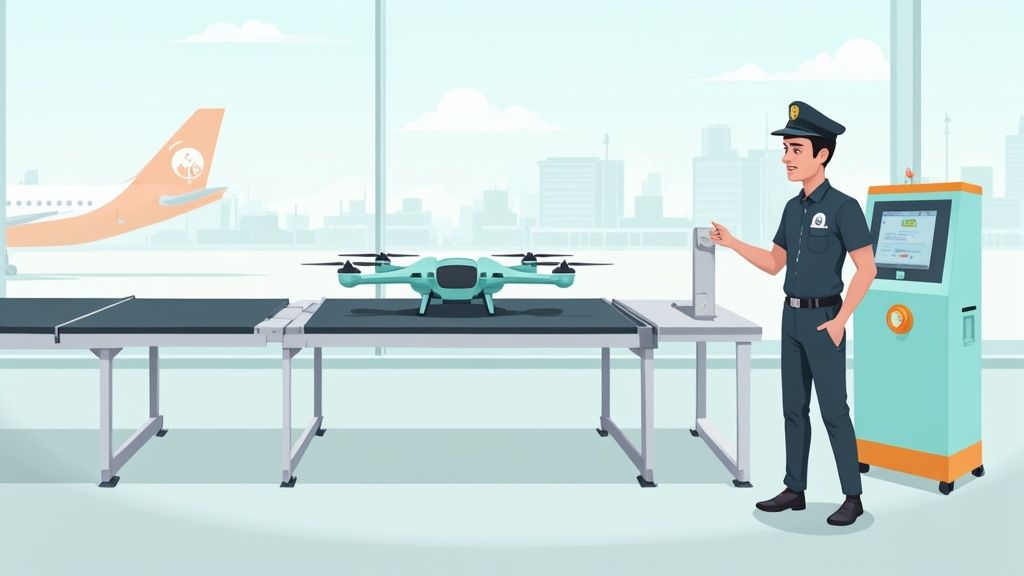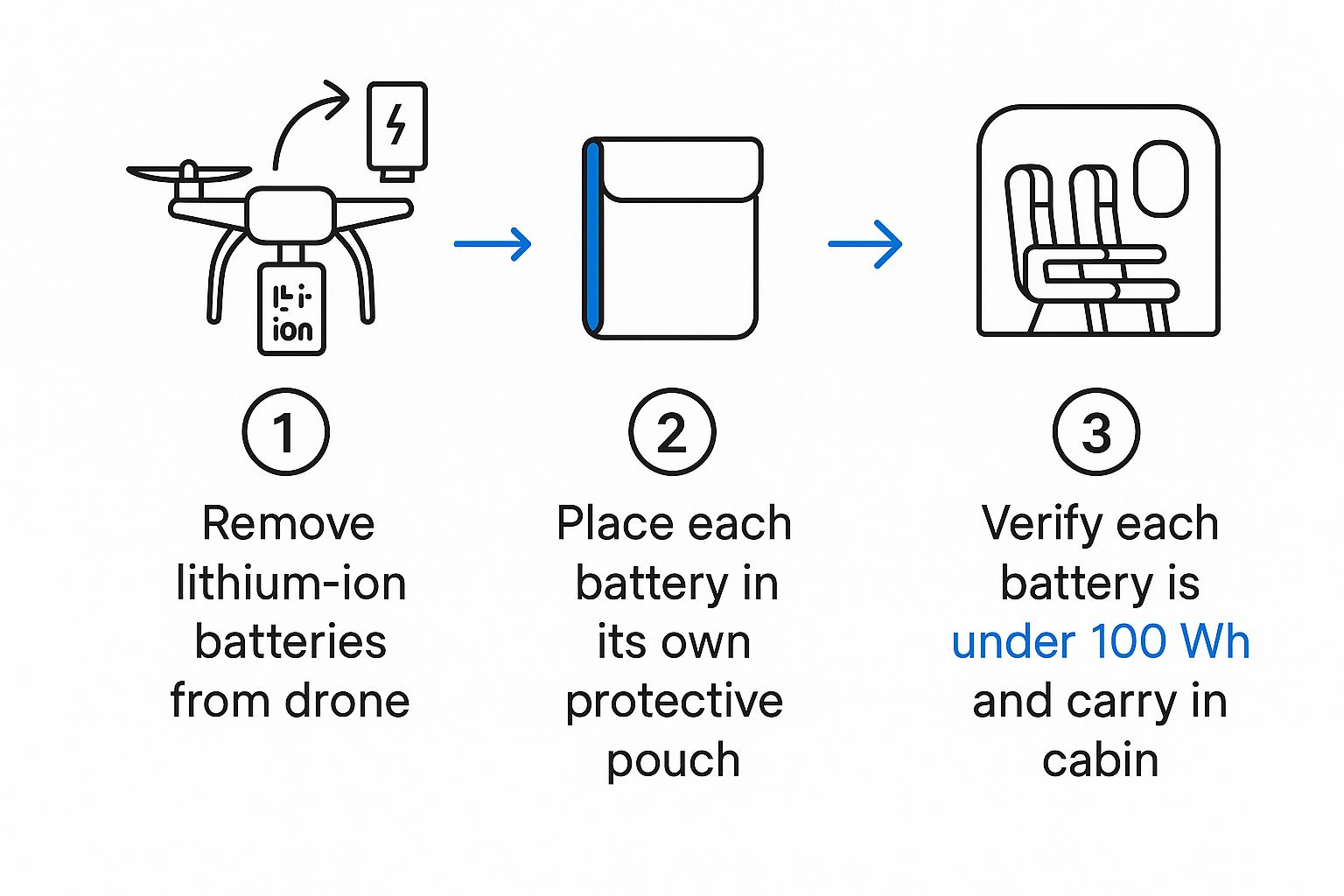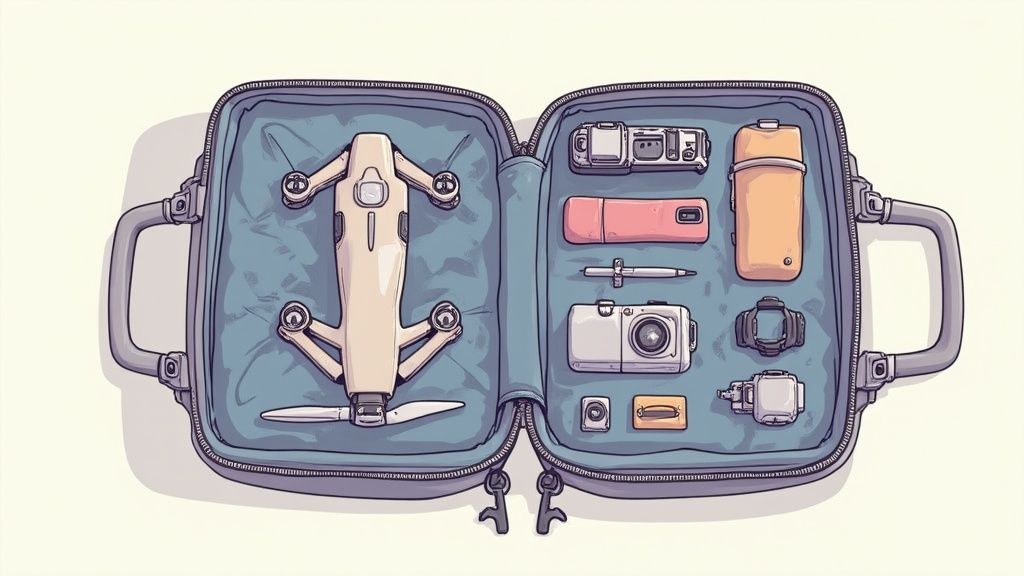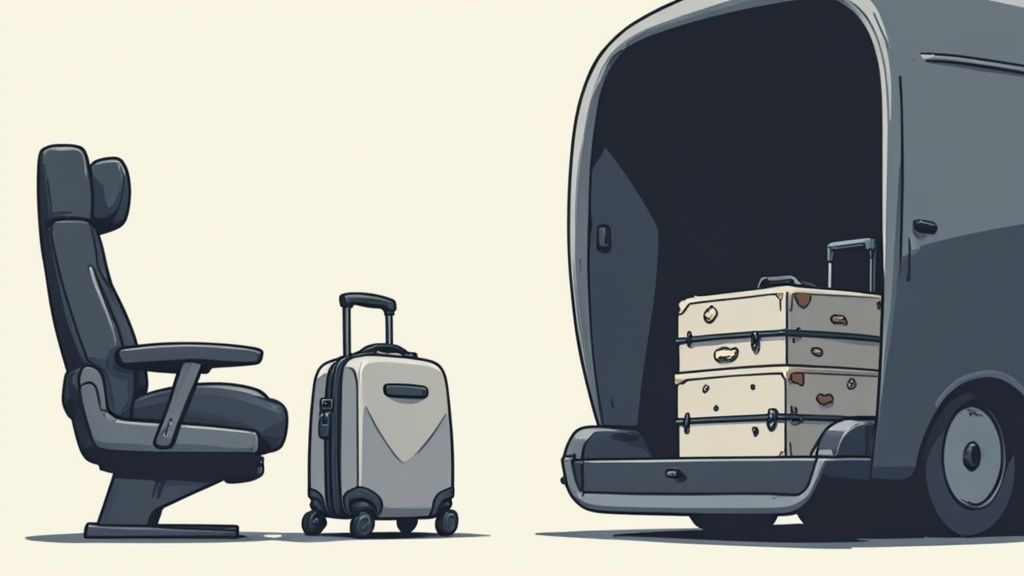Can I Take a Drone on a Plane? A Pilot's Guide
- Jab Media

- 4 days ago
- 11 min read
Of course you can fly with a drone. The short answer is yes, you can absolutely take a drone on a plane, whether in your carry-on or checked bag.
But there's one critical detail that makes all the difference: the batteries. Those powerful lithium-ion batteries that keep your bird in the air almost always have to fly in the cabin with you, right in your carry-on baggage.
Getting Through the Airport: The Basics of Flying with Your Drone

Here's the easiest way to think about it for a smooth trip through security: your drone's body and its batteries are two completely separate items. The drone itself, without a battery clicked in, is no big deal. You can usually pack it in either your carry-on or your checked luggage without any issues.
The real star of the show for airline and security staff is the power source.
Lithium-ion batteries are officially classified as dangerous goods in the world of aviation. It’s not that they’re likely to cause a problem, but because of the small—though serious—risk of fire. By keeping them in the cabin, the flight crew can get to them and deal with any potential issue immediately. That's why the rules around them are so rigid.
Carry-On vs. Checked Luggage: The One Rule to Remember
So, what's the bottom line? Pack the drone body wherever you’ve got space, but make sure every single spare battery is with you in the cabin.
What if you want to leave one battery inside the drone you’re checking? You can, but you have to make absolutely sure the drone is powered off completely and packed in a way that it can't possibly turn on by accident.
Pro Tip: I never check my drone. Ever. My entire setup—the drone, the controller, and all my batteries—goes into my carry-on backpack. This isn't just about following the battery rules; it's about protecting thousands of dollars of gear from the notoriously rough-and-tumble world of checked luggage.
Aviation authorities around the globe are on the same page about this, but the specifics can vary slightly. Most airlines follow the guidelines set by the International Air Transport Association (IATA). These rules generally permit lithium-ion batteries under 100 Watt-hours (Wh) in your carry-on without needing special permission from the airline.
For bigger batteries, specifically those between 100Wh and 160Wh, you'll need to get the airline's approval before you fly. As regulations evolve, it's always a good idea to stay updated on international drone laws that might affect your travel plans.
To make things simple, here's a quick cheat sheet for where to pack your gear.
Drone Travel at a Glance: Carry-On vs. Checked Luggage
Component | Carry-On Luggage | Checked Luggage | Key Consideration |
|---|---|---|---|
Drone Body | Recommended | Permitted | Best kept in carry-on to prevent damage. |
Spare Batteries | Required | Prohibited | Must be in carry-on due to fire risk. |
Controller | Recommended | Permitted | Contains a Li-Ion battery, so carry-on is best. |
Battery in Drone | Permitted | Permitted (with caution) | Must be fully powered off and secured. |
Accessories | Permitted | Permitted | Propellers, chargers, etc., can go in either bag. |
Ultimately, keeping your entire drone kit with you in your carry-on is the safest and simplest way to travel, ensuring you stay compliant and your gear stays in one piece.
Mastering Drone Battery Rules for Air Travel
When you're packing your drone for a flight, the batteries are what security and airline staff care about most. Forget the drone body for a second—it’s the lithium-ion (LiPo) batteries that get all the attention. They’re classified as dangerous goods for one simple reason: fire risk.
This potential hazard is the single biggest reason for the strict rules you'll encounter. In fact, lithium-ion batteries have been linked to about 50% of all aircraft cargo fires reported in the last decade. It’s no surprise, then, that nearly 95% of commercial airlines follow IATA’s lithium battery guidelines. A recent study even found that 18% of passengers flying with drones ran into problems with their batteries at security checkpoints.
The 100 Watt-Hour Rule
If there’s one number to burn into your memory, it’s 100 watt-hours (Wh). This is the magic threshold that determines how easy your journey will be.
Any drone battery under 100Wh is generally fine to bring in your carry-on luggage. You won't need to get any special permission from the airline. Most consumer drones you see everywhere—like the DJI Mini or Air series—have batteries that fall safely below this limit, making travel a breeze.
Now, for batteries between 100Wh and 160Wh, you have to get approval from the airline before you fly. These are usually the bigger batteries for professional rigs. You’ll need to have a chat with the airline when you book your ticket or at the check-in counter. Anything over 160Wh is a hard no for passenger flights and must be shipped as dedicated cargo.
This graphic breaks down the essential steps for getting your batteries ready for the airport.

As you can see, the core principles are simple: batteries come out of the drone, get protected individually, and stay with you in the cabin.
Preparing Your Batteries for Screening
A little prep work before you leave home will save you a world of headaches at the security checkpoint. The golden rule is that spare batteries—any battery not installed in the drone—are forbidden in checked luggage. They must be in your carry-on. No exceptions.
Here’s how to pack them safely:
Insulate the terminals. The biggest danger is a short circuit. The easiest way to prevent this is by covering the metal contacts with a small piece of electrical tape. You can also keep each battery in its original box.
Use LiPo-safe bags. These fire-resistant pouches add an extra layer of protection. They also signal to security agents that you know what you’re doing and have taken the proper precautions.
Keep them accessible. Don’t bury your batteries at the bottom of your bag. Pack them near the top of your carry-on, because there's a good chance you’ll be asked to take them out for a separate inspection.
By keeping all batteries in your carry-on, you ensure the flight crew can quickly address any issue, which is the entire basis for these regulations. For more in-depth advice on battery maintenance and safety, check out our guide on caring for LiPo batteries.
How to Pack Your Drone for Safe Travels

Packing your drone for a flight isn't just about preventing damage—it's about making your trip through airport security as painless as possible. If you want to take a drone on a plane without any headaches, it all starts with how you pack. The first big decision you'll make is your choice of bag.
A hard case gives you bulletproof protection, which is great if you ever get forced to check your drone. The downside? They're often bulky and heavy, which is a real drag when you're navigating a packed airport. A dedicated drone backpack, however, is built for travel, with custom foam inserts that cradle your gear perfectly.
Prepping Your Gear for Inspection
Before you even think about zipping up that bag, a few quick steps can make all the difference for a speedy security screening and prevent any accidental damage in transit. It’s a couple of minutes of work that really pays off.
Remove Propellers: Always take them off. It’s the easiest way to keep them from getting bent or snapped inside the bag.
Secure the Gimbal: Use that little plastic gimbal clamp that came with your drone. It locks the camera mechanism in place and protects it from all the bumps and shakes of travel.
Organize Cables: Neatly coiled cables and a tidy controller make it much easier for TSA agents to see what’s on the X-ray scanner.
The goal is to pack so you can pull out the drone and its batteries for inspection in seconds. This little bit of organization shows security you’re a prepared traveler and can help you avoid a time-consuming secondary bag search.
I always place my LiPo-safe battery bags in a separate tray right next to my laptop. This proactive step clearly communicates to security staff that I understand the rules and have packed my gear accordingly.
Beyond just the drone gear, a well-organized carry-on makes everything smoother. For more general advice on packing smart, check out these essential packing tips for travel. And remember, having the right paperwork is just as important as packing right; you can learn more about the cost of getting a drone licence to make sure you're ready to fly legally when you land.
Know the Rules for Your Airline and Destination
Getting your batteries past the TSA is a big win, but it's not the end of the line. Your next challenge is navigating the specific rules of your airline and the laws of the country you're flying to. Don't make the mistake of assuming a TSA green light means you're cleared everywhere else.
Airlines have their own policies for carry-on items, and these can absolutely impact whether you can take a drone on a plane. Before you even start packing, pull up your airline's website. You're looking for their section on "dangerous goods" or "restricted items," which will spell out their specific rules for lithium batteries and the maximum size for your carry-on bag.
Check the Airline's Fine Print
It’s so important to get this information directly from the source, because these policies can change without any warning. Search for terms like "drones" or "unmanned aerial vehicles (UAVs)" to see if they have any specific language.
Here’s a pro tip I always follow: take a screenshot of the policy page on your phone. If you run into a check-in agent who isn't sure about the rules, having that official policy handy can clear things up in seconds.
A quick five-minute check on your airline's website can save you from a massive headache at the airport. It's the best way to make sure your expensive gear doesn't get left behind or, worse, confiscated.
Researching Your Destination's Drone Laws
This part is even more critical than the airline's rules. Showing up in a new country with a drone you can't legally fly is a rookie mistake you don't want to make.
Drone laws are all over the map, literally. Some countries require you to register your drone and get a permit before you even think about flying, even as a hobbyist. Others have incredibly strict no-fly zones that you need to be aware of.
For instance, many destinations have tight restrictions around sensitive areas like national parks or government buildings. To stay out of trouble, always look up the drone laws for your destination before you go. This is especially true for protected lands; we have a whole guide on the importance of drone restrictions in national parks if you want to learn more.
There's a growing movement to standardize these rules. The European Union Aviation Safety Agency (EASA), for example, has a set of regulations that apply across all its member countries, including a requirement for all drone operators to register. With over 1 million registered drones in the European market, it’s clear why understanding these international rules is non-negotiable. You can read more about these global drone policy trends on Dronelife.com.
To help you stay organized, I've put together a simple checklist to run through before you head to the airport.
Pre-Flight Checklist for Drone Pilots
Checklist Item | Why It's Important | Where to Find Information |
|---|---|---|
Check Airline Policy | Every airline has unique rules for battery capacity (Wh), carry-on size, and whether drones are allowed. | The airline’s official website under "Dangerous Goods" or "Restricted Items." |
Research Destination Laws | Avoid fines or confiscation by knowing the local rules for registration, no-fly zones, and permits. | The country’s official civil aviation authority website or dedicated drone law apps. |
Pack Batteries Correctly | Prevents short-circuits and fire risks, a key requirement for both TSA and airlines. | TSA and FAA websites provide clear guidelines on battery transport. |
Print or Screenshot Rules | Having proof of the rules can quickly resolve disputes with airline staff who may not be familiar with them. | Airline website and the official government drone regulation page for your destination. |
Running through these steps might seem tedious, but trust me, it’s a lot less painful than having your travel plans derailed at the check-in counter. A little bit of preparation goes a long way.
Getting Through Airport Security Smoothly

Knowing the rules is one thing, but actually standing in that security line is where the rubber meets the road. I've found the key to a stress-free trip through the scanner is simply being ready to answer any questions the TSA agents might have, clearly and confidently.
Here’s my go-to strategy: I keep a few key documents saved as screenshots on my phone. Specifically, I have the airline’s drone policy and the official TSA page for lithium batteries ready to pull up. I also make sure I have a clear photo showing the watt-hour (Wh) rating of my batteries. This way, if an agent has a question, I can show them official documentation in seconds.
This little bit of prep work helps you sidestep the common issues that can lead to a secondary inspection. Agents are far more likely to pull you aside if your drone is just shoved into a messy bag or if you seem hesitant about your battery specs.
Pro Tip: When your bag hits the conveyor belt, treat your drone and LiPo battery bag just like a laptop. Take them out of your main bag and place them in a separate bin. This immediately signals to the agents that you know what you’re doing and you’ve followed the rules.
Stay Confident, Stay Courteous
Your real goal here is to make the security agent’s job as easy as possible. Be prepared to explain what you've got, but don't volunteer a novel's worth of information unless they ask.
Most of the time, a simple, "That's my camera drone, and the batteries are packed safely right here, per regulations," is all you'll ever need to say.
Ultimately, being organized and informed is your fastest ticket through security. For a complete deep dive into all the rules, check out our guide on how to [take a drone on a plane](https://www.jabdrone.com/post/can-i-bring-drone-on-plane-essential-travel-tips)—it covers every travel tip you could need.
Common Questions About Flying with a Drone
Even after you've memorized the main rules, real-world situations at the check-in counter can still throw you for a loop. Let's walk through some of the most common questions pilots ask before heading to the airport, so you’re ready for anything.
Do I Need to Declare My Drone at Check-In?
For the drone itself, not usually. If you’ve packed it in your carry-on, there's generally no need to make a big formal declaration. The real conversation is about the batteries.
If you’re carrying any LiPo batteries between 100-160Wh, you absolutely must declare them. These require explicit approval from the airline. For your standard, under-100Wh batteries, it’s still a great idea to give the check-in agent a heads-up. A simple, "Just wanted to let you know I have my drone batteries packed safely in my carry-on," shows you know what you’re doing and can prevent any confusion down the line.
Can I Bring a Large Professional Drone?
This is where it gets a lot more complicated. A beast of a drone like a DJI Inspire often has a body that's simply too big for standard carry-on luggage. That alone might force you to check it.
The much bigger hurdle, though, is the batteries. Those high-capacity power packs frequently blow past the 160Wh limit for passenger aircraft. Any battery that powerful is a no-go for your flight and has to be shipped separately as dangerous goods via a specialized cargo service.
If you're flying with professional gear, your very first call should be to the airline's cargo department. Don't wait until the last minute—reach out weeks in advance to get a handle on their specific rules. The last thing you want is to be forced to leave thousands of dollars of equipment behind on travel day.
What Happens If My Drone Gets Damaged in Checked Luggage?
This is the nightmare scenario, and unfortunately, the airlines aren't much help. Their liability for items in checked baggage is incredibly limited, and high-value electronics are almost always on their list of exclusions. Honestly, this is the single best reason to do whatever it takes to keep your drone out of the cargo hold.
If checking it is your only option, invest in a top-tier, crush-proof hard case. Before you even leave the house, take time-stamped photos of your drone and the case to document its condition. Even better, look into a travel insurance policy that specifically covers electronics. It's a small price to pay for a safety net in case the baggage handlers have a bad day.
At JAB Drone, we're committed to helping you explore the world from new heights, safely and confidently. For more expert tips and in-depth reviews, visit us at https://www.jabdrone.com.




コメント